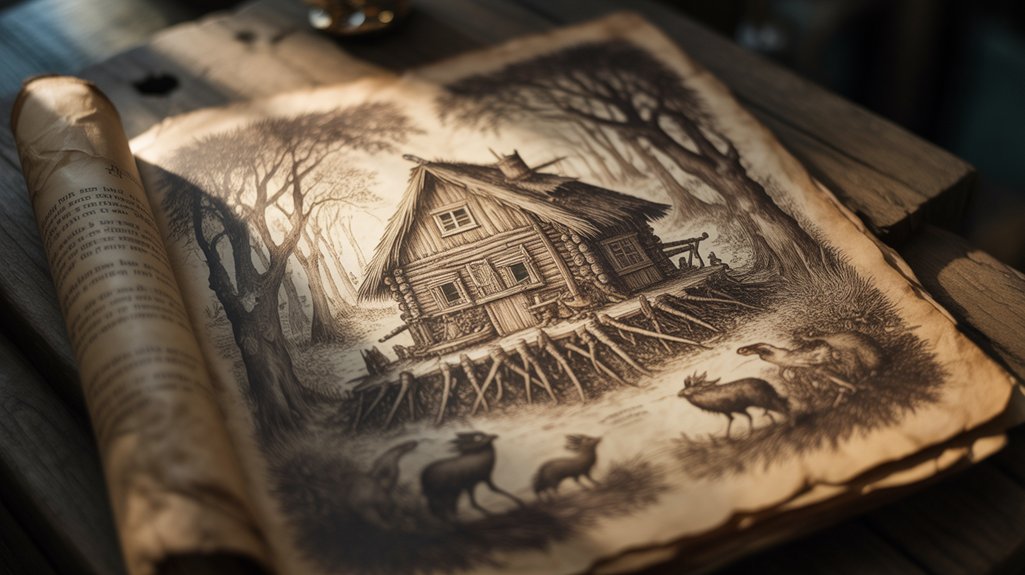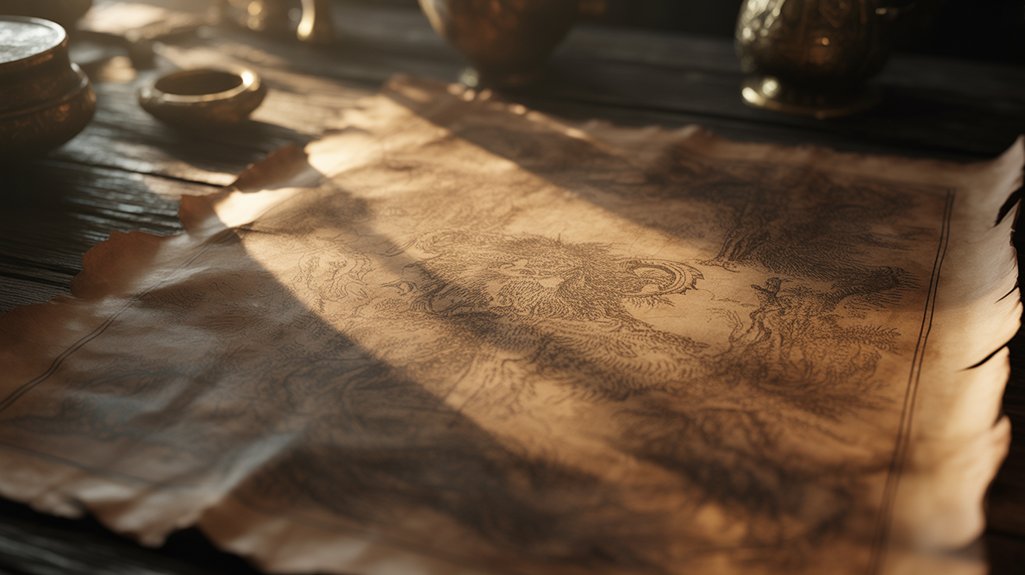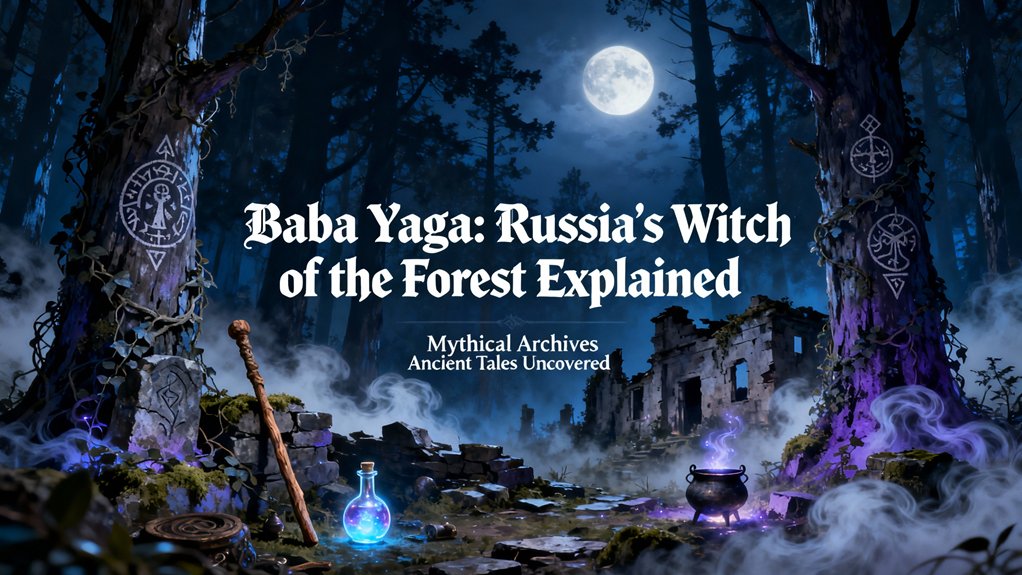You'll encounter Baba Yaga as Slavic folklore's most enigmatic figure—a primordial crone who predates Christian cosmology, dwelling in her chicken-legged hut at civilization's edge. She's neither villain nor benefactor but a liminal force testing your worthiness through impossible tasks: sorting grain, fetching fire, answering riddles that measure your authentic self. This bone-mother, shamanic guardian of life-death thresholds, devours the disrespectful while aiding those who approach with reverence. Her dual nature continues echoing through modern adaptations, preserving ancient feminine power that refuses conformity—mysteries that unfold through deeper exploration.
Key Takeaways
- Baba Yaga is a pre-Christian Slavic figure representing nature's dual forces of creation and destruction.
- She dwells in a rotating hut on chicken legs at the boundary between civilization and wilderness.
- Baba Yaga tests seekers through impossible tasks, helping the worthy and devouring the disrespectful or lazy.
- Her character originates from ancient shamanic traditions where crones wielded power over life and death.
- Modern adaptations in literature, film, and gaming preserve her essence as untamed, primal feminine power.
The Origins and Ancient Pagan Roots of Baba Yaga

Though her chicken-legged hut has haunted Slavic imagination for centuries, Baba Yaga's origins stretch back into the pre-Christian darkness of Eastern Europe, where she emerged not as literary invention but as something far older—a primordial force woven from the animistic beliefs of Indo-European peoples who understood forests as threshold spaces between worlds.
Baba Yaga: not literary fiction but primordial force—born from animistic darkness where forests marked the threshold between mortal and otherworldly realms.
You'll find her roots entangled in pagan mythology predating the 10th-century Christianization of Kievan Rus', when shamanic crones wielded power over life and death. She embodies the eldritch forest deity—neither wholly malevolent nor benevolent—reflecting ancient reverence for nature's dual capacity to nurture and destroy.
Her chimeric dwelling, perched on fowl legs, signals her role as boundary-keeper between civilization and wilderness. Folklore traditions preserved her through oral transmission across generations, altering yet maintaining her essential nature as death-goddess, wisdom-keeper, and initiator.
She's your inheritance from ancestors who recognized power in aged women, storms, and bone-strewn clearings where mortality pressed close.
The Chicken-Legged Hut and Iconic Symbols of the Bone Mother
Where civilization ends and chaos begins, Baba Yaga's hut spins on its gruesome foundation—a dwelling that defies architectural logic, rotating upon enormous chicken legs (or sometimes duck, goose, or crane appendages, depending on regional variation) that grant it uncanny mobility across the Russian taiga.
You'll find this forest dwelling positioned deliberately at thresholds: where village meets wilderness, where known changes into unknowable. The structure itself embodies chimeric contradiction—domesticity merged with monstrosity, shelter that simultaneously threatens.
Those skeletal limbs, often described as yellowed and scaly, raise the izba above mundane earth, creating what scholars term a “liminal architecture” that exists between terrestrial and celestial domains.
The hut rotates. Endlessly.
Surrounding this eldritch edifice, you'll encounter her other iconic symbols: the fence constructed from human bones, topped with blazing skulls whose empty sockets illuminate the forest's depths.
The mortar and pestle she pilots through night skies. Each element signals her dominion over life's boundaries, her role as keeper of change's violent threshold.
Baba Yaga's Dual Nature: Helper and Devourer

When confronting Baba Yaga across folktale traditions spanning five centuries of documented Russian oral narrative, you'll discover she refuses singular classification—this grandmother-crone operates simultaneously as malevolent child-eater and wisdom-dispensing benefactor, her actions contingent upon the seeker's worthiness rather than any fixed moral alignment.
| When She Devours | When She Assists | The Determining Factor |
|---|---|---|
| Lazy protagonists become meals | Respectful seekers receive magical objects | Proper ritual address |
| Uninvited trespassers face her iron teeth | Humble servants gain prophecy | Completion of impossible tasks |
| Discourteous children enter her cooking pot | Pure-hearted maidens escape with blessings | Demonstrated courage |
Baba Yaga's ambivalence mirrors the eldritch wilderness itself—neither benign nor purely destructive. The nature of assistance she provides—enchanted combs altering into forests, advice revealing hidden paths—emerges only after supplicants demonstrate competence, bravery, deference. This chimeric grandmother embodies primal testing, forcing freedom-seekers to prove their sovereignty through action rather than entitlement.
Tests, Trials, and Encounters With Heroes in Slavic Tales
The morphology of Baba Yaga's trials reveals recurring patterns across documented Slavic narratives—three impossible tasks forming numerical symmetry, household servitudes testing stamina and cleverness, riddles probing cosmological understanding.
You'll find heroes confronted with eldritch demands: sort grain from sand by dawn, fetch fire from her bone-fenced domain, answer questions about white day and black night. These magical trials strip away pretense.
In documented heroic quests from 16th-century compilations, Vasilisa receives impossible commands—washing bloodstained linens, cooking meals for invisible servants, separating poppy seeds from earth.
The witch's chimeric household operates beyond natural law. You're watching initiation rites disguised as folklore, death-and-rebirth scenarios where protagonists surrender childhood certainties.
The hut's spinning threshold marks alteration. Those who approach with respect, bearing gifts, speaking truth—they receive aid. The discourteous? Devoured.
Baba Yaga's tests measure more than competence; they penetrate soul-deep, revealing whether you've earned passage into authentic selfhood beyond societal constraints.
Baba Yaga's Influence on Modern Literature, Film, and Popular Culture

Since her emergence from forest-dwelling oral traditions into printed collections, Baba Yaga has undergone metamorphic changes across contemporary artistic media—her bone-legs striding from Slavic villages into global consciousness. Modern interpretations reimagine her eldritch essence through cinema, novels, and digital domains, where she manifests as mentor, antagonist, or chimeric guardian of threshold wisdom.
| Medium | Notable Work | Portrayal |
|---|---|---|
| Literature | *Deathless* by Catherynne Valente | Complex trickster-goddess |
| Film | *Hellboy* (2019) | Vengeful supernatural force |
| Gaming | *Thimbleweed Park* | Quest-giver archetype |
Baba Yaga adaptations preserve her liminal potency while accommodating contemporary narrative structures. Her chicken-legged hut appears in graphic novels, her mortar-and-pestle flight echoes through fantasy franchises. This enduring presence demonstrates how ancient Slavic wisdom-keepers transcend temporal boundaries, offering modern audiences confrontation with primal feminine power—untamed, unapologetic, eternally changing. She persists because freedom-seekers recognize her refusal to conform.
Frequently Asked Questions
Is Baba Yaga Considered Evil or Good in Russian Folklore?
You'll find Baba Yaga's morality defies Western binaries—she exists beyond simple categorization.
This eldritch crone embodies profound duality: she devours the foolish, yet grants wisdom to respectful seekers.
Her chimeric nature reflects ancient Slavic understanding that forest spirits operate by their own codes, not human ethics.
She tests heroes, punishes greed, rewards courage.
You're encountering a liminal figure who mirrors nature itself—neither benevolent nor malicious, but utterly autonomous, demanding respect rather than judgment.
What Does the Name “Baba Yaga” Actually Mean in Russian?
Like peeling bark from an ancient birch, you'll discover “Baba” means “grandmother” or “old woman” in Slavic tongues, while “Yaga” remains etymologically elusive—scholars debate whether its linguistic roots trace to Proto-Slavic words for “anger,” “shudder,” or “serpent.”
This chimeric naming reflects Baba Yaga's symbolism itself: simultaneously familiar elder and eldritch terror.
The ambiguity grants you interpretive freedom, allowing the crone's essence to shift between protective ancestral wisdom and primal, untamed wilderness force dwelling beyond civilization's boundaries.
Are There Real Places in Russia Associated With Baba Yaga Legends?
You'll find Baba Yaga's Locations scattered across Russia's primordial landscape, though she transcends fixed geography.
The dense forests of Tver Oblast claim her presence, ancient birch groves whisper her name. Villages near Yaroslavl maintain shrines. She haunts the Urals' eldritch depths.
This Folklore Geography reveals something essential: she dwells wherever wilderness meets civilization, in liminal thresholds between settlement and untamed forest.
She's everywhere. Nowhere. The geography shifts because Baba Yaga herself embodies metamorphosis, existing beyond cartographic certainty in Russia's collective memory.
How Do You Properly Pronounce “Baba Yaga” in Russian?
You'll pronounce it “BAH-bah yah-GAH,” stressing the final syllable with guttural precision. This phonetic guide reveals the witch's name rolling from Slavic tongues like incantation itself.
The first “a” sounds as in “father,” the second carries that same open vowel. Pronunciation tips from native speakers emphasize the hard “g”—never soft like English “giant.”
Let each syllable resonate separately, honoring the ancient nomenclature that has summoned this eldritch forest deity across centuries of whispered tales.
Did Baba Yaga Exist in Folklore Outside of Russia and Slavic Countries?
Like Hecate at her crossroads, Baba Yaga remains distinctly Slavic.
You won't find her chicken-legged hut wandering beyond Eastern European borders—her origins root deeply in Russian, Ukrainian, and Polish soil.
However, she mirrors global witch archetypes: Italy's Befana, Germany's Frau Holle, Celtic cailleachs.
These eldritch crones share her chimeric nature—death-bringer and wisdom-keeper intertwined.
You're witnessing parallel evolution, not migration: cultures independently conjuring liminal feminine power, ancient and untamed, dwelling at civilization's edge.
Conclusion
You've glimpsed her skeletal visage through centuries of folklore, traced her chicken-legged dwelling across Slavic consciousness. When a Moscow theatre director recently staged *Vasilisa the Beautiful*, audiences wept—recognizing Baba Yaga's eldritch wisdom still resonates within modern psyches. She endures because you need her: the crone who devours pretense, the guardian of liminal thresholds between childhood and change. In confronting this chimeric figure, you encounter humanity's oldest truth—growth demands passage through the forest's darkest heart, where bone mothers wait.

